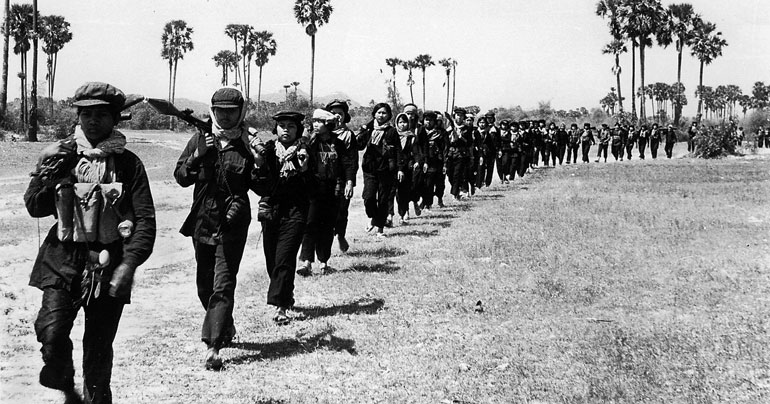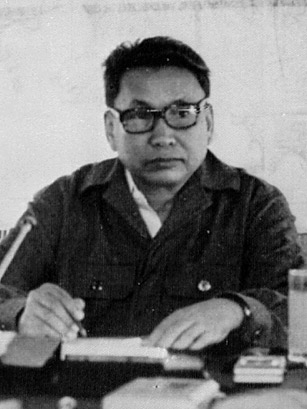What was Democratic Kampuchea? In short Democratic Kampuchea was the Khmer Rouge state that governed Cambodia from April 1975, until their overthrow in December of 1979.
Despite its rather short tenure it is one of the most controversial states to have ever existed. And despite officially being overthrown in 1979, the “state” continued in some shape, or form until 1998/1999.
This is Democratic Kampuchea
Prelude to what was Democratic Kampuchea
Cambodia was initially a French colony and part of French Indochina. Following World War 2 and the independence fight with the French, Indochina was split into 4 countries. Namely North Vietnam, South Vietnam, Laos and Cambodia. Only one of these states at the time was communist, North Vietnam ran by Ho Chi Minh. But socialist tendencies ran deep throughout the region, which in turn would lead not only to the Vietnam War, but the whole region becoming a falling domino.
The main rebel organization in Cambodian initially were the Khmer Issarak, who in turn would morph into the Peoples Revolutionary Party of Kampuchea, a socialist organization with close ties to the Vietnamese.
To read about the Khmer Isaraak click here.
The forerunner of the Khmer Rouge
The Peoples Revolutionary Party of Kampuchea was initially formed in 1951. The current ruling Cambodian Peoples Party tracing their lineage to this date. In 1960 the party was largely taken over by a group of students who had met in Paris and had been part of the Khmer Students Association. The party would move towards Maoism and rename itself the Workers Party of Kampuchea.
To read about the Khmer Students Association click here.
In 1971 and at the behest of their Chinese allies they would change their name into the Communist Party of Kampuchea, led by Pol Pot and with a standing committee largely made up of the group who had met in Paris during the 1950’s.
The initial insurgency
The Workers Party of Kampuchea retreated to the countryside and began their insurgency against the government. Whilst undoubtedly a strong military force initial successes were at best limited. The were also not the only insurgency of the time. There was also the Khmer Bleu, who ironically were fighting against the government of Sihanouk as they found it “too communistic”.
To read about the Khmer Bleu click here.
At this point the Americans were also bombing large swaths of Cambodia, particularly parts that fell into the Ho Chi Minh trail. But, it was to be another American move that would sway their fortunes.
The 1970 CIA Coup Against Sihanouk
In 1970 the CIA sponsored a coup against Sihanouk by Lon Nol who proclaimed the Khmer Republic. This was not only extremely unpopular, but underestimated just how popular the King remained.
At the behest of his friends in China and North Korea Sihanouk formed an alliance with the Khmer Rouge, which would be known as the GRUNK. Due to the popularity of Sihanouk many people thought they were fighting for him, rather than the Khmer Rouge. This coupled with continued American bombing and the ineptitude of the Lon Nol regime slowly led to the Khmer Rouge winning the Cambodian Civil War.
The start of Khmer Rouge State
The Khmer Rouge entered Phnom Penh on April 17th 1975. This was to be the beginning of the rule of the Communist Party of Kampuchea in Cambodia and their warped view on socialism. They almost immediately emptied the cities into the countryside as part of the Super Great Leap Forward and executing their enemies. This was though not the start of Democratic Kampuchea, at least officially.
Early communist Cambodia was technically at least run by the coalition GRUNK, headed by Sihanouk. And whilst Sihanouk was never proclaimed king, he was head of state, with the government and army referring to themselves as the Royal Government. Weirdly similar to what had recently happened in Laos.
To read about the 3 princes of Laos click here
Formation of Democratic Kampuchea
For the ultra-communist Khmer Rouge they were never going to remain “royal” for very long and wanted to declare a workers state, and with Sihanouk further marginalized moved on with thus plan.
Democratic Kampuchea was officially proclaimed on January 6th 1976, after the Party Congress that was held in the proceeding December. Therefore between April 17th 1975 and January 5th 1976 Cambodia had been a royalist government with Sihanouk as head of state. This was as part of the GRUNK, or to give it is full English title the Royal Government of National Union of Kampuchea.
Constitution of what was Democratic Kampuchea
With the abolition of the GRUNK and the formation of Democratic Kampuchea a new constitution was set into place. This was extremely reminiscent of other Communist constitutions. Ironically things such as private property and freedom of religion were enshrined in it.

To read the constitution of Democratic Kampuchea click here.
Interestingly the constitution of Democratic Kampuchea also theoretically set out the foreign policy of the country, namely that it would be a neutral autarky.
To read about the foreign relations of Democratic Kampuchea click here.
Government of Democratic Kampuchea
The first head of state was Sihanouk, who after his resignation was replaced with Khieu Samphan, who had largely been seen as the polite face of Cambodian communism.
In reality though the country was run under the bother system by the Standing Committee of the Communist Party of Kampuchea, a group that was to change only marginally from the 1950’s right up until 1996.

To read about the Standing Committee of the Communist Party of Kampuchea click here.
At the head of Angkar (the organization) was Pol Pot, with Nuon Chea as his second in command. Quite how much power either wielded is definitely open to debate.
To read abut Pol Pot click here.
To read about who the real leader of the Khmer Rouge was click here.
Democratic Kampuchea and the cambdoian genocide
It is impossible to discuss the Khmer Rouge regime without discussing the genocide. Yet whilst it often painted as simply “Mad” there was a lot more to it.
The policy of the CPK was to advance to socialism in 4 years. To do this they would initiate the “Super Great Leap Forward”. This would mean moving everyone to the countryside, growing a bumper harvest of rice, selling it for billions and then industrializing the country.
They also wanted to rid the country of all enemies during this time. The unrealistic aims and paranoia of the regime inevitably caused famine. So, whilst the regime did murder numerous amounts of innocent people, the vast majority were to die of the dire conditions created by the Khmer Rouge in Democratic Kampuchea.
To read about the Super Great Leap Forward click here.
The end of Democratic Kampuchea
Among the many paranoias the government of the DK had one of the most pervasive was a hatred of the Vietnamese. They also wanted to create a “Greater Kampuchea”, by of course taking land from the Vietnamese. This meant that the Khmer Rouge would make frequent border incursions into Vietnamese territory.
There are many reasons why this was absolute folly, but to list a few. The Vietnamese had been fighting almost constantly since the 1940’s. The Cambodians were weak due to he famine and deaths caused by the Khmer Rouge, and lastly the Khmer Rouge drastically misplayed their cards.
China had been and would continue to be an ally of the Khmer Rouge, but they were not prepared to protect Democratic Kampuchea militarily. The Chinese even suggested that the Khmer Rouge enter peace talks with the Vietnamese, something they refused to do, but which as historical accounts attest the Vietnamese would have accepted.
Thus when the Vietnamese did eventually invade they met a weak population who by and large welcomed them as liberators.
To read about why Democratic Kampuchea fell click here.
The Vietnamese were to overthrow “Democratic Kampuchea” in December of 1979, which would eventually be replaced by the Peoples Republic of Kampuchea. This was not though to be the end of Democratic Kampuchea.
The continuation of the Khmer Rouge
Everybody knew the crimes of the Khmer Rouge in Democratic Kampuchea, but sadly the west really did not want a Soviet ally in power in Cambodia. Thus the Khmer Rouge were allowed to not only keep the seat at the UN, but remain the recognized government.
This would continue until 1982 when Sihanouk, seemingly a man happy to make the same mistake twice again got into bed with the Khmer Rouge. A mirror version of the GRUNK was formed this time known as the Coalition Government of Democratic Kampuchea.
To read about the Coalition Government of Democratic Kampuchea click here
They would continue controlling their own fiefdom whilst fighting the legitimate government of the country, with the small pockets they controlled still being called Democratic Kampuchea.
Peace and the last Khmer Rouge state
A tacit peace was agreed in 1991, whereby the elections would be held and the Khmer Rouge would reiterate into politics. Alas when 1993 came the Khmer Rouge boycotted them and retreated into the area they controlled, which was still called “Democratic Kampuchea”.
After their party was declared illegal they proclaimed the catchily titled The Provisional Government of National Union and National Salvation of Cambodia (PGNUNSC). With the National Army of Democratic Kampuchea still as their armed wing.
To read about the last Khmer Rouge state click here/
Over the next 5 years there were numerous defections, as well as the death of Pol Pot, before the last vestiges of the Khmer Rouge and indeed Democratic Kampuchea were dissolved in June of 1998.
Ta Mok, the last paramount leader of the Khmer Rouge was finally captured in 1999 with a small band of loyalists. Nobody has claimed the lineage of either the Khmer Rouge, or Democratic Kampuchea.
To explore the history of the Khmer Rouge and Democratic Kampuchea join our Dark Tourism Cambodia Tour.





